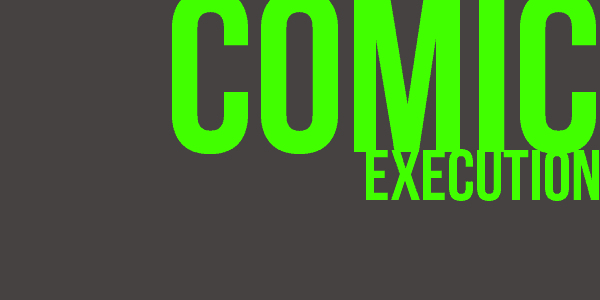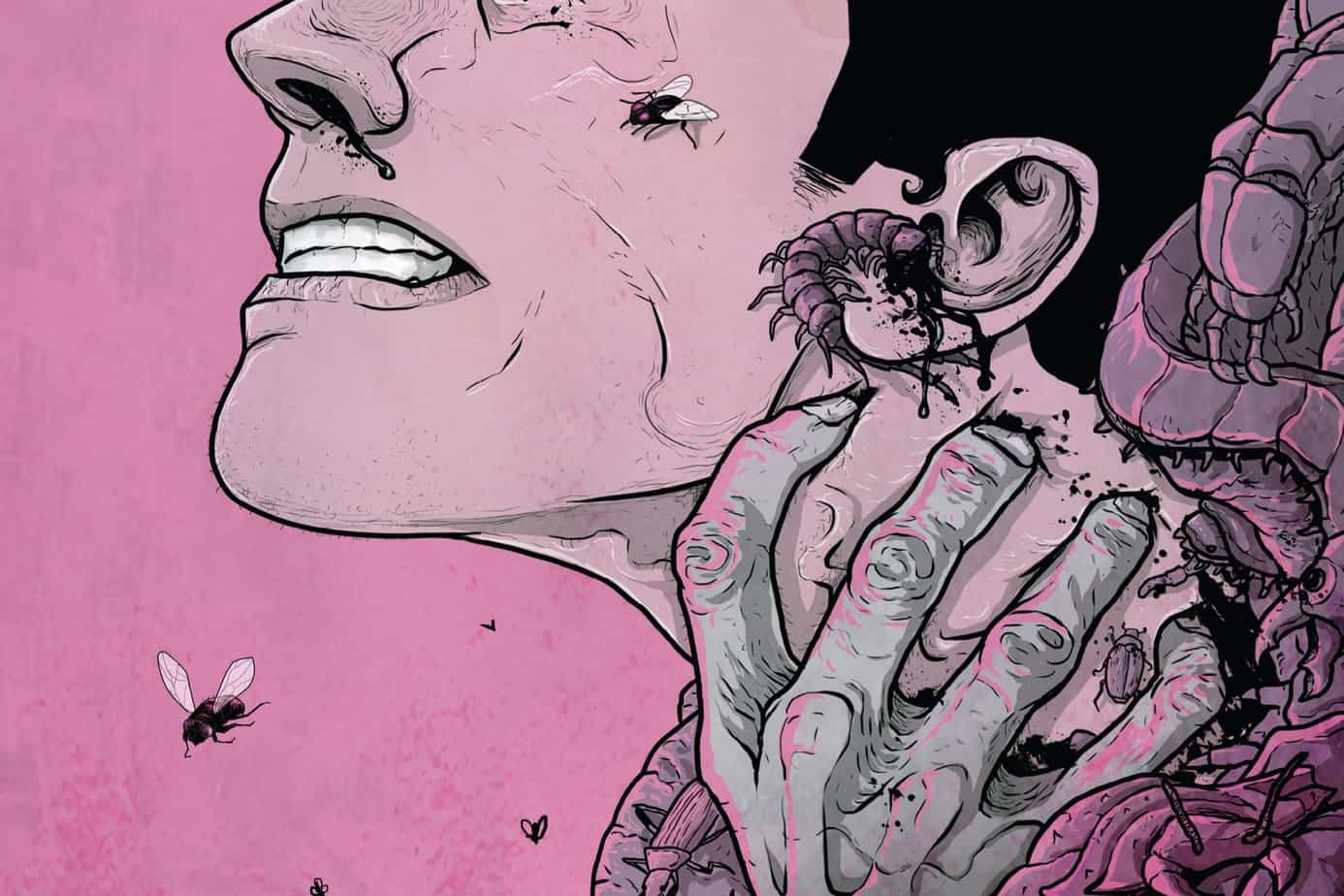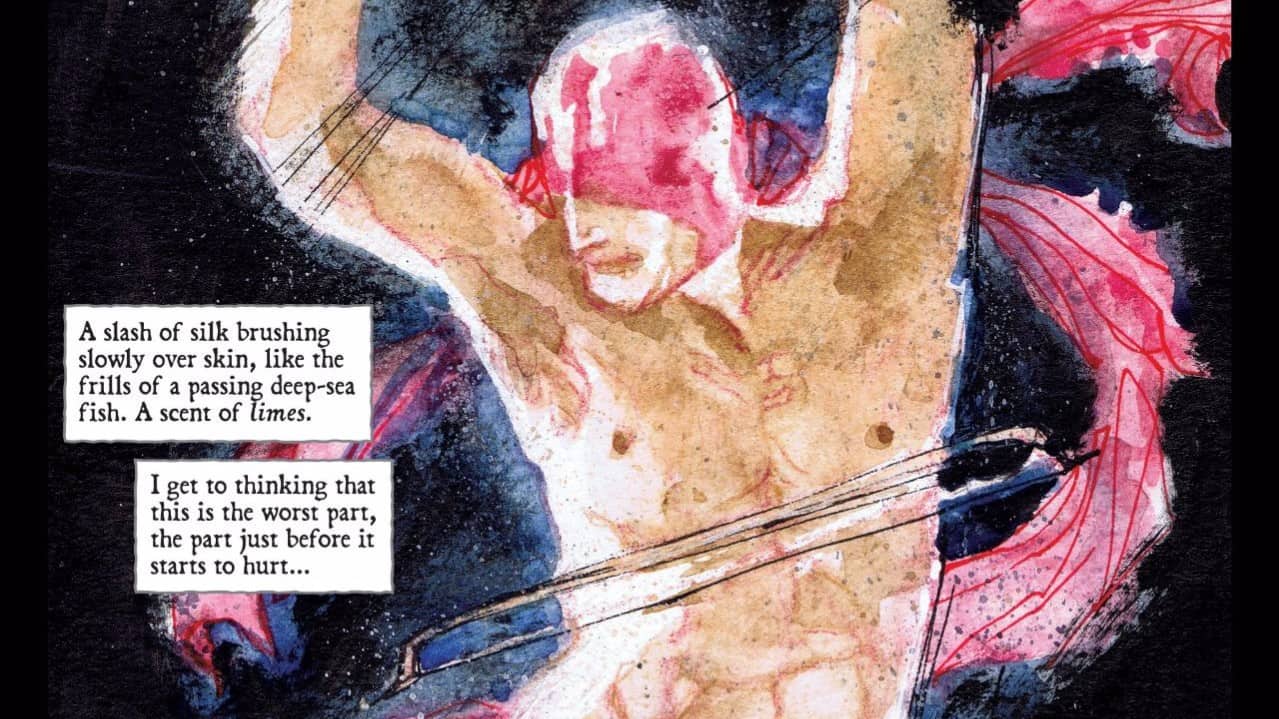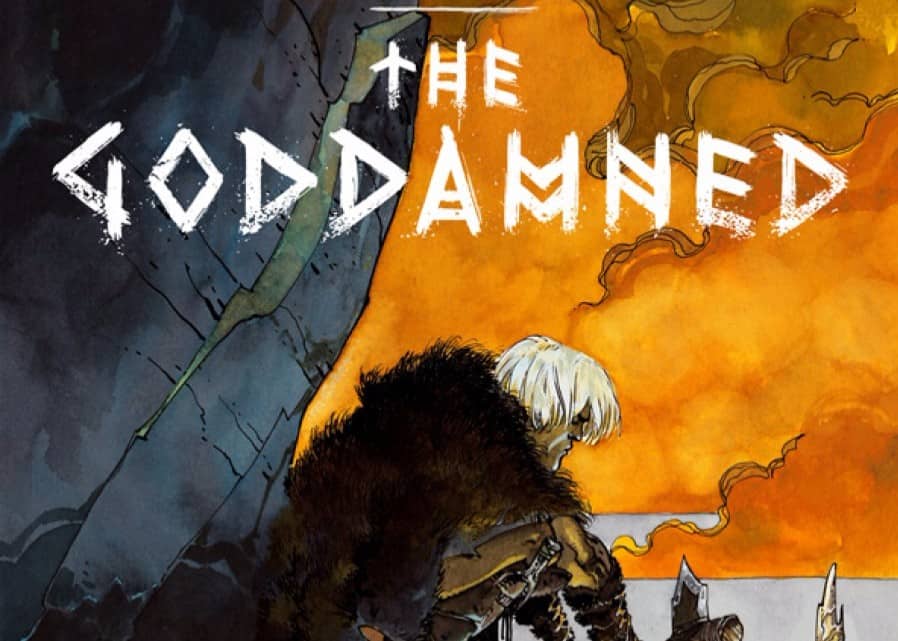
[Comic Execution] 2/21 – ‘THE UNDERTOW’, ‘GHOSTED’, ‘LOKI: RAGNAROK AND ROLL’
So I got an e-mail from ‘Minimum Wage’ author Bob Fingerman regarding my most recent criticism of his comic. He answered one question: “Regarding the ‘By Bob Fingerman’ tag on #2, the design of the whole cover apes that of sleazy spinner-rack adult novels that littered drugstores, etc., in the ’60s and ’70s…” I definitely didn’t pick up on this so I very much appreciate his illumination on the subject. “As for the ‘Bob Fingerman’s’ on all other issues,” he contiues, “that’s partly a nod to the ego of John Carpenter (whose name as possessive adorns all his movie titles) and also a practical/pragmatic nod to branding. Unseemly, perhaps, but kind of necessary.” I’m definitely interested in why Bob felt it was necessary but it’s strictly a matter of curiosity and not one of disagreement.
But he also got to the meat of my objections to the latest issue of ‘Minimum Wage’: “And as to the 20-page vs. 24-page length, the first issue was written and drawn before the ink was even dry on the contract, so I’d written it as 24-pages. Since I literally do every aspect of the production, the publisher suggested dropping the page count to 20 so I could maybe have a day off once in a while.” As someone who doesn’t make comic books, I don’t necessarily assume that every creator struggles with the creative process. Some artists and writers scribble their ideas in a mad fury while others languish in agony as they try to wring inspiration from their brains. When Bob elaborated that doing the comic by himself meant eschewing any kind of extended freedom from the act of comicking, I understood that I had underestimated the difficulty he has in bringing these stories to life. Given that, I think it’s reasonable to dismiss the troubling drop in quantity in the latest ‘Minimum Wage’ issue. I certainly don’t want to be the reader who expects superhuman feats from the writers and artists I admire.
What still bothers me though (and you’ll see this come up again in my GHOSTED review) is that ‘Minimum Wage’ is far from the only Image Comics series that has seen drops in book size. Most, if not all, of their series have lost four pages on average and we’re not just talking about from #1 to #2, like with ‘Minimum Wage’. This has happened ACROSS THE BOARD. And, not coincidentally, it comes at a time when Image Comics has the fastest growing share of the comic book market, not to mention their impressive roster of talent. At one point I was told by an author that a 20-page volume was excusable because that was the industry standard. This certainly seems to contradict the regular contrasts Image’s representatives make publicly about how Image is unlike the rest of the comic book industry, particularly the Big Two.
In the end, my gripe isn’t with Bob. It’s with Image, a company I used to think was trying to change the way the industry worked. Now, with their unpublicized cuts in page numbers, I’m not so sure. What’s the deal, Image?
 THE UNDERTOW #1
THE UNDERTOW #1
Writer: Steve Orlando
Artist: Artyom Trakhanov
Publisher: Image Comics
Price: $3
There certainly seems to be a proliferation of oceanic-themed comics as of late. ‘Great Pacific’, ‘The Massive’, ‘The Wake’, ‘The Mercenary Sea’ are the ones I can name off the top of my head. They’re all good books with a strong variety of story though, so I certainly won’t begrudge them the recurring motif. Doesn’t change the fact that it’s getting just a bit monotonous, though perhaps my low-level resentment is due to my living right on the confluence of America’s two largest rivers and thusly having more affinity for rivers than lakes or oceans (‘cuz hey, drinkable water + water travel). So I approached THE UNDERTOW with quite a bit of weariness but also with no clue what I was getting myself into: the cover told me almost nothing, featuring a strange character punching up through water to air. It’s as visually striking as a cover could be but also told me almost nothing other than that this guy was either the villain or the hero. Or both.
His name is Redum and it turns out he’s a bit of both. Amazingly, within the first half-dozen pages, THE UNDERTOW manages to merge the disparate narratives of all the aforementioned comics into one surprisingly robust tale. Atlantis hasn’t yet sunk and a rebellious movement to explore the primitive world above sees Redum leading his people into forbidden lands as well as into battle with Atlantean powers-that-be. It kicks off with a very surreal undersea struggle that explicitly illustrates how serious the conflict is as well as showing us how advanced the technology is that they use. It is a little disappointing that the main protagonist, once pitted against Redum but now at his side, is immediately transparent as a sort of outside observer whose arc is already telegraphed long before he’s even integrated Redum’s organization.
Yet the clever inversion of the space opera trope is so well executed, I barely noticed the irritating cliche. It’s a hard sell to make the concept seem anything other than a lame effort to avoid being slotted into the role of yet another sci-fi space epic, but author Steve Orlando (whose only prior comic book effort being a story in the ‘Mystery In Space’ anthology from Vertigo) convincingly cultivates as robust foam of detail that would normally derail a tricky narrative like this. His “I’m-just-here-for-exposition” protagonist helps but, if you’ll pardon the cliche, there’s just so much information woven into the narrative that you only really notice the individual strands if you’re looking for them. For example, an attack by massive birds midway serves not just to pack more action into the story but to illustrate how dangerous the ancient world is, despite their advance technology. And not moments later, a neat visual trick explains how the craft houses hundreds of water-breathing Atlanteans away from the ocean.
People talk a lot about “world-building” but I find it often happens at the expense of a page-turning momentum that is so important in comics, assuming you’re not presenting the kind of art that you can deeply get absorbed in, ala Geof Darrow or Aaron Conley. What’s thrilling about THE UNDERTOW is that newcomer artist Artyom Trakhanov packs every panel to the brim with layers of enthralling detail, imbuing each character with distinctive identities and rendering the Atlantean tech with a genuinely impressive blend of realism and weirdness. He takes on fantastical interiors, beautiful terrain, fierce creatures, epic battles and quiet moments of character development with equal footing, sometimes lapsing into a hurried bit of sloppiness but never distractingly so; again, you’d really have to be looking for the problems to find them.
The other anchor of THE UNDERTOW is colorist… wait a minute. TRAKHANOV IS THE COLORIST. That is crazy because, like his linework, Trakhanov perfectly balances a blooming palette of hot colors with chilled purples and blues but isn’t afraid to take on earthier hues, punching through those milder moods with blasts of neon energy. Then there’s the panel work, which manages to be both encompassing and dynamic, zoomed crops and narrow frames dotting the book, enlivening the already breathtaking proceedings.
THE UNDERTOW sees an above-average sci-fi tale paired with some of the best visual work in the genre I’ve seen since HARD-BOILED. The story itself isn’t as inventive as I’d like but fortunately it rests on the kind of “world-building” that I wish every sci-fi writer could manage. At Image’s cut-rate pricing for this hefty volume, fans of sci-fi or beautiful art can’t miss this debut and everyone else should take a look as well. Assuming the next issue is as lush and enjoyable, I could definitely see reading this alongside ‘Great Pacific’ or ‘The Wake’.
GHOSTED #7
Writer: Joshua Williamson
Artist: Davide Gianfelice
Colors: Miroslav Mrva
Publisher: Image Comics
Price: $3
This week, a customer at my LCS asked me what ‘Ghosted’ was. I described it as “if ‘Ghostbusters’ was a Michael Mann joint” and the series never quite disappoints the oddball nature of that pairing. There are times where the seams are visible but it hasn’t fallen apart yet, even under the duress of extending the original concept into a second story arc.
The second issue of this new arc ups the violence quotient of the series by the gallon. But it does so sneakily by opening with a sly moment of black comedy, fiendishly subverting what would’ve been an irritating trope and introducing a new character. There is a puzzling flashback that seems to float into the scene but Williamson has proven in the past that his diverse threads dovetail nicely when the time comes so I’m having patience with this momentum-tripping moment. Thankfully, Williamson rebounds from it with precisely the kind of thrilling, over-the-top nastiness I’d hoped for from this story. There’s a chase scene and a delightfully gory execution courtesy a malevolent phantasm whose motives become clearer and, frankly, more enjoyable by the moment. GHOSTED may not have a single decent upstanding human being in the whole of its cast, but the ghost is quickly becoming one of my favorites.
There’s intrigue abound when we’re introduced to what is apparently a haunted temple used by a really cool looking gang. This arc feels like Williamson was bored with the haunted mansion setting of GHOSTED’s debut and decided to overcompensate. It does feel a bit dislocated, like we’re seeing a totally different story interjected with familiar characters but it’s not as though the motivations for said characters’ presences are implausible. We saw how they got there, it’s just such a jarring tonal shift from earlier that I’m still not comfortable with it yet.
[toggle title=”Spoiler Section (Expand at Your Own Risk!)”]This isn’t helped at all by the out-of-the-blue abundance of cheesecake that appears in the climax. It’s not just a page of T&A, it’s a full page spread that hammers the point home rather crudely. Sure, the build-up is pure comedic gold; we’ve been led to believe that the scene would be utterly blood-chilling so the reveal is briefly chuckle-worthy. But it’s also a waste of potential storytelling. Would I be complaining if there was some beefcake tossed in their for my own enjoyment? Probably not. Fact stands, I bought the comic and I’m basically being treated to a visual feast of something I am utterly unmoved by with the assumption I’m going to be titillated, yes, titillated, by it. Again, I wouldn’t be so annoyed if it didn’t take up a whole two pages. One scene. The monologue accompanying it is useless, reiterating the obvious. And then the next panel, more cheescake, again takes up a half a page and pretty much blatantly admits that we’re supposed to be ogling the goods, if not for ourselves then on the protagonist’s behalf.[/toggle]
Fortunately, Williamson can’t help but warping the sexiness into horror and the tale ends poorly for our anti-hero, as usual. Williamson’s writing is still great but I’m definitely disappointed in the decision to let the balance of visuals and narrative tilt away from the latter near the end of the book.
Speaking of the visuals, Gianfelice delivers solidly again with #7, rendering the gritty back alleys with disturbing acuity and implementing violence in full effect. Characters remain wonderfully distinctive in their lovably sleazy manner even as they’re viciously murdered. Ghosts and demons alike are fantastically weird and menacing, each panel has lovingly crafted backgrounds, it’s just a really good looking book. Which makes the two and a half pages of Goth Illustrated Swimsuit Edition that much more frustrating. Especially since this is also the shortest issue of the series, at a meagre 20 pages. How did this series go from a valuable offering of 30 pages to losing ten of those?
Now this is only the second issue of the new arc, fortunately. I’m going to give Williamson and Gianfelice the benefit of the doubt (colorist Mrva gets a pass for being consistently brilliant) and wait this out for the next issue. But if there’s anymore shenanigans like what I saw in this GHOSTED, I’m executing the series. I don’t MIND looking at half-naked women for several pages but let’s not make it a thing, yeah? At least not unless you’re going to offer up something for your alternatively minded readers.
 LOKI: RAGNAROK AND ROLL #1
LOKI: RAGNAROK AND ROLL #1
Writer: Eric M. Esquivel
Artist: Jerry Gaylord
Publisher: BOOM! Studios
Price: $4
So this Loki guy is a thing right now with the kids, I hear? Hiddleston’s to blame, I guess. But Loki’s got the angst thing going on too and that’s always in style. I’ve never really been into Norse mythology, it seems heavy on the Shakespearean drama. I like my mythologies to be a little trippier; hello Huehueteotl! I suppose, since Krampus got a comic, it was just a matter of time before there was a comic devoted strictly to the Matt Damon to Thor’s Ben Affleck.
But wait! There’s a twist! It’s not just a comic about Loki, but about metal too!
Fuck.
The comic immediately introduces itself to me by suggesting I listen to a Mastodon song from the last album they did that wasn’t radio-ready fedora music (that’d be ‘Leviathan’ for the uninitiated). Or, it naively offers, perhaps you’d prefer a Marilyn Manson song from the same era. Something tells me somebody doesn’t think much of the current climate of metal. Oh, Dio and The Rolling Stones are on tap? I think I’m done here.
Well, at least it starts off well, the omniscient narrator (but WHICH NORSE GOD IS IT??!!) dryly informing the reader on the generalities of Asgard. The dialogue has a restrained snappiness to it but there’s also no real subtlety to the characterizations, which I suppose is excusable since these are mythological deities. Still, it would have actually been interesting to see the usual routine subverted rather than played (rather poorly) for laughs. There’s the usual betrayal that apparently isn’t a betrayal at all and Loki ends up on Earth. He runs into a “metal” concert by coincidence, there’s more stupid characters, he becomes a goth, starts a band, Thor comes back. Stupid characters, dumb story. It’s perfectly crafted to wring maximum teen angst from the plight of an ancient deity.
The art’s all right. It’s got that Joe Mad exaggeration that’s so prevalent among a certain subset of artists which is both a boon and a curse, making it impossible to take anything seriously. Fortunately, that’s not really the thrust of the book. There’s a lot of detail but nothing memorable or exciting. There’s a scene where all the gods show up. That’s kind of fun. Well, except for the really strange inclusion of a gay god in the form of a chinese rabbit? Who’s the butt of a joke? I really have no idea what to make of this comic.
I’m executing LOKI: RAGNAROK AND ROLL for being the comic book equivalent of a Marilyn Manson album. Except cute.



